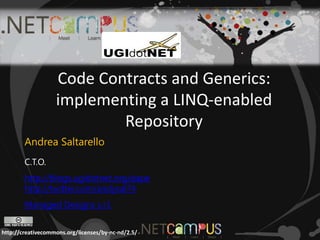Code Contracts and Generics: implementing a LINQ-enabled Repository
•
0 gostou•503 visualizações
In questa sessione vedremo come implementare il Repository pattern in modo da creare un Data Access Layer interrogabile mediante query LINQ, delegando l'effettiva esecuzione delle stesse ad O/RM quali Entity Framework e/o NHibernate.
Denunciar
Compartilhar
Denunciar
Compartilhar
Baixar para ler offline

Recomendados
Recomendados
Mais conteúdo relacionado
Semelhante a Code Contracts and Generics: implementing a LINQ-enabled Repository
Semelhante a Code Contracts and Generics: implementing a LINQ-enabled Repository (20)
Cert04 70-484 - essentials of developing windows store apps

Cert04 70-484 - essentials of developing windows store apps
Slide typescript - xe dotnet - Codemotion Rome 2015

Slide typescript - xe dotnet - Codemotion Rome 2015
Mais de Andrea Saltarello
Mais de Andrea Saltarello (9)
Da Rotor a .NET Core ed indietro: Microsoft <3 Open Source

Da Rotor a .NET Core ed indietro: Microsoft <3 Open Source
The Fine Art of Time Travelling: implementing Event Sourcing

The Fine Art of Time Travelling: implementing Event Sourcing
Layered Expression Trees: una terza via (idiomatica) verso il DDD

Layered Expression Trees: una terza via (idiomatica) verso il DDD
Code Contracts and Generics: implementing a LINQ-enabled Repository
- 1. Code Contracts and Generics: implementing a LINQ-enabled Repository Andrea Saltarello C.T.O. http://blogs.ugidotnet.org/pape http://twitter.com/andysal74 Managed Designs s.r.l. http://creativecommons.org/licenses/by-nc-nd/2.5/
- 2. Sponsor Sponsor Platinum Sponsor Gold
- 3. Agenda • Chi • Quisquilie IT • Perché • Come • Q&A
- 4. Repository pattern [P of EAA, 322] Mediates between the domain and data mapping layers using a collection-like interface for accessing domain objects.
- 5. Code Contracts: OverView I “Software Contract” sono specifiche formali del comportamento di una unità di codice espresse mediante l‟uso di 3 elementi: • Espressioni invarianti, che sono vere sia prima sia dopo l‟invocazione della funzione • Precondizioni, che esprimono le condizioni nelle quali una funzione può essere invocata • Postcondizioni, che esprimono il funzionamento delle funzioni Nota: è possibile verificare questi elementi mediante l‟uso di asserzioni, che implementeremo mediante unit testing
- 6. VS2010 vs. Code Contracts Il FX 4.0 include il supporto ai Code Contracts ma occorre «abilitarlo» installando: • il Code Contract toolkit per VS2010 (d/l da sito Microsoft Research) • [Opzionale] le estensioni Code Contract per VS2010
- 8. Repository pattern A system with a complex domain model often benefits from a layer, such as the one provided by Data Mapper (165), that isolates domain objects from details of the database access code. In such systems it can be worthwhile to build another layer of abstraction over the mapping layer where query construction code is concentrated. This becomes more important when there are a large number of domain classes or heavy querying. In these cases particularly, adding this layer helps minimize duplicate query logic. … You can also find a good write-up of this pattern in Domain Driven Design.
- 9. Repository: as easy as 1-2-3 1. Il Repository occorre per persistere un Domain Model 2. La «Bibbia» del Domain Model è [DDD] 3. E vediamolo, „sto DDD
- 10. DDD Architecture
- 11. DDD Key Concepts (redux) • Il Domain Layer contiene la domain logic ed è composto da – Model: Entità (identità e stato) e Valori (solo stato) – Servizi • Entità e Valori a runtime formano dei grafi di oggetti. I grafi dotati di “dignità propria” sono chiamati Aggregate e il sistema (es: i Repository) si “impegna” a gestirli correttamente ed atomicamente • Le istanze di entità/aggregate sono costruite da Factory (pattern Builder [GoF])
- 12. Da 0 ad Aggregate • E' un insieme di elementi raggruppati in un‟unità logica, quindi un grafo di oggetti • Ha come radice l'entità principale dell'aggregato • La radice è l‟unico elemento che può essere referenziato fuori dai confini dell‟aggregato • Non è possibile agire direttamente sugli elementi senza passare dalla radice dell'aggregato • L‟aggregate ha la responsabilità di implementare la propria logica
- 13. Domain Model
- 14. Repository pattern (Reloaded) Mediates between the domain and data mapping layers using a collection-like interface for accessing domain objects. Ricapitolando: • Interfaccia “collection like” • Gestisce la persistenza degli Aggregate • LINQ! (siamo dei buongustai )
- 15. IRepository<T>
- 16. Demo code: NSK Progetto open source (licenza CPL) disponibile su CodePlex: http://nsk.codeplex.com
- 17. Bibliografia [DDD] Domain Driven Design, Eric Evans, Addison-Wesley [P of EAA] Pattern of Enterprise Application Architecture, Martin Fowler, Addison-Wesley
